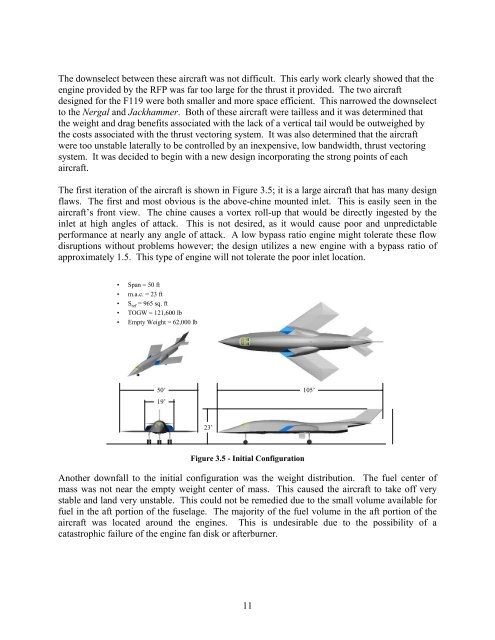SAWE Report - Cal Poly San Luis Obispo
SAWE Report - Cal Poly San Luis Obispo
SAWE Report - Cal Poly San Luis Obispo
You also want an ePaper? Increase the reach of your titles
YUMPU automatically turns print PDFs into web optimized ePapers that Google loves.
The downselect between these aircraft was not difficult. This early work clearly showed that the<br />
engine provided by the RFP was far too large for the thrust it provided. The two aircraft<br />
designed for the F119 were both smaller and more space efficient. This narrowed the downselect<br />
to the Nergal and Jackhammer. Both of these aircraft were tailless and it was determined that<br />
the weight and drag benefits associated with the lack of a vertical tail would be outweighed by<br />
the costs associated with the thrust vectoring system. It was also determined that the aircraft<br />
were too unstable laterally to be controlled by an inexpensive, low bandwidth, thrust vectoring<br />
system. It was decided to begin with a new design incorporating the strong points of each<br />
aircraft.<br />
The first iteration of the aircraft is shown in Figure 3.5; it is a large aircraft that has many design<br />
flaws. The first and most obvious is the above-chine mounted inlet. This is easily seen in the<br />
aircraft’s front view. The chine causes a vortex roll-up that would be directly ingested by the<br />
inlet at high angles of attack. This is not desired, as it would cause poor and unpredictable<br />
performance at nearly any angle of attack. A low bypass ratio engine might tolerate these flow<br />
disruptions without problems however; the design utilizes a new engine with a bypass ratio of<br />
approximately 1.5. This type of engine will not tolerate the poor inlet location.<br />
• Span = 50 ft<br />
• m.a.c. = 23 ft<br />
• S ref = 965 sq. ft<br />
• TOGW = 121,600 lb<br />
• Empty Weight = 62,000 lb<br />
50’<br />
19’<br />
105’<br />
23’<br />
Figure 3.5 - Initial Configuration<br />
Another downfall to the initial configuration was the weight distribution. The fuel center of<br />
mass was not near the empty weight center of mass. This caused the aircraft to take off very<br />
stable and land very unstable. This could not be remedied due to the small volume available for<br />
fuel in the aft portion of the fuselage. The majority of the fuel volume in the aft portion of the<br />
aircraft was located around the engines. This is undesirable due to the possibility of a<br />
catastrophic failure of the engine fan disk or afterburner.<br />
11













